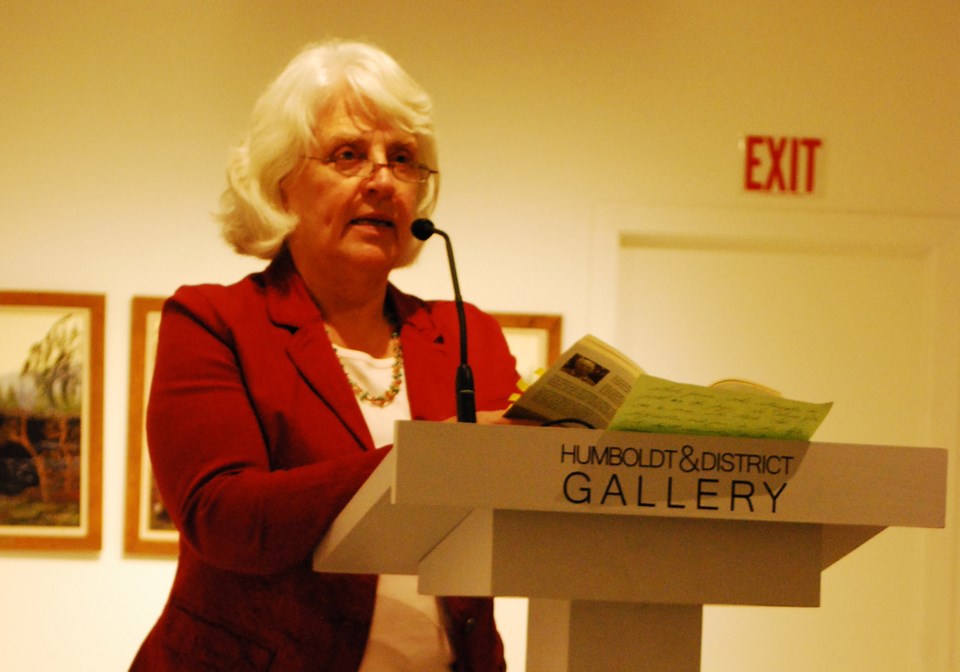The crowd that braved the cold for a book launch of Alphonse Gerwing’s memoir proved that he was well-known and appreciated in the community. His niece, Connie Gerwing, has worked on and off since 2002 putting the memoir together and did a reading at the Humboldt Gallery in conjunction with the Humboldt and District Museum and Gallery and the Reid-Thompson Library on Dec. 2.
Gerwing began her presentation by asking how many people knew Al and many hands went up.
“Very few people didn’t know him,” she said. He has worked in Annaheim, Carmel, and Muenster and grew up in Lake Lenore, and so was a fixture in the region.
On the urging of friends and family, Al began working on his memoirs in 2002 with Gerwing helping him type and put them together. When he died in 2007, she decided to work on finishing and releasing his memoirs. Her role was mainly to organize the memoirs and add context. She said that sometimes she had to explain who or what something was. Her writing appears in the book in italics.
“I think he had a really interesting life,” she said. “He did a lot of really interesting things and he was a complex man as well. I think that it’s a story that needs to be told.”
She began working on the memoirs in earnest within the last year, and self-published through McNally Robinson, an experience that she enjoyed. Her favourite part of putting the book together was doing the research. However, she had no hesitation naming her least favourite part.
“Picking out the typos,” she laughed. She reread the book seven or eight times in addition to having other people read it as well.
She also enjoys doing readings at various places. After Humboldt, she is speaking in Saskatoon, Lake Lenore, Edmonton, and Wainwright, Alta. Prior to Humboldt, she gave readings in Winnipeg and Prince Albert.
“He knew people all over,” Gerwing said.
In Prince Albert, one of the attendees who used to work with Al recounted seeing him at work with two differently-coloured socks. In Humboldt, one attendee recalled going to Brazil with him.
“You can see people interested and engaged in listening,” Gerwing said. “You can tell they have their own little stories too.”
Gerwing talked about his many projects, including starting a choir in Annaheim and getting the Von Trapp family to perform in the area.
“Even when he was down, it didn’t take much to get him back up again and excited about something,” she said. “Lots of the time he didn’t know how to do things … he just thought, ‘This would be a good idea!’ and away he went. He was not afraid to take risks.”
He asked to get the Von Trapps in the region, but they would only come if Al could find them six engagements in the prairies. He succeeded and they performed a few times in the area. Maria von Trapp was not a fan of the prairies.
“’At the Mount (in Carmel), she immediately intoned a Te Deum of thanksgiving, grateful to have escaped death in this godforsaken land’,” Gerwing read from the memoir.
The family almost cancelled their engagement in Muenster, but bucked up and got through.
“He’d think, ‘Yeah, why can’t I take a choir from Germany and travel them all over western Canada? Sure I can do that!’ So he did,” Gerwing laughed.
Gerwing found that before his death, Al didn’t write a lot about his later life, including his work in Brazil. He did a lot of work with street kids there, helping to build dormitories and homes. He began these projects in his 60s and ended up learning Portuguese. Gerwing said that sometimes he would take a couple thousand dollars to Brazil and just hand it out.
“I think he was somebody from here, just a small place, and not born into any sort of importance. He really managed to affect and change people’s lives, from the community around him to places like Brazil,” Gerwing said.
In fact, there’s a charitable organization that bears his name that is dedicated to continuing his projects. All proceeds from the book will go to the Alphonse Gerwing Foundation.
“The Al that we all knew, or most of us knew, was a man full of life, full of energy, full of enthusiasm,” Gerwing said in her talk. “As I’m sure you know, things happened when he was around. There was always music, there were always stories, there were always projects, projects, and more projects.”
The book can be purchased at the Humboldt Museum for $26.



